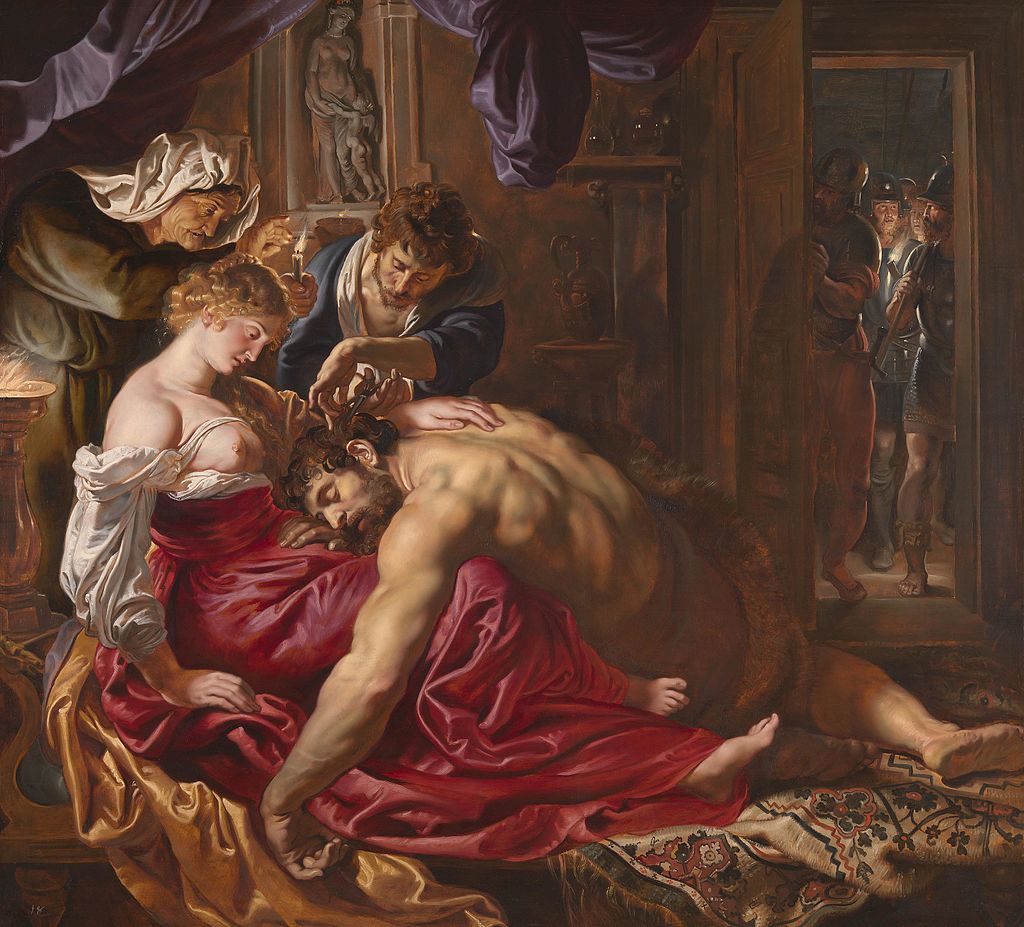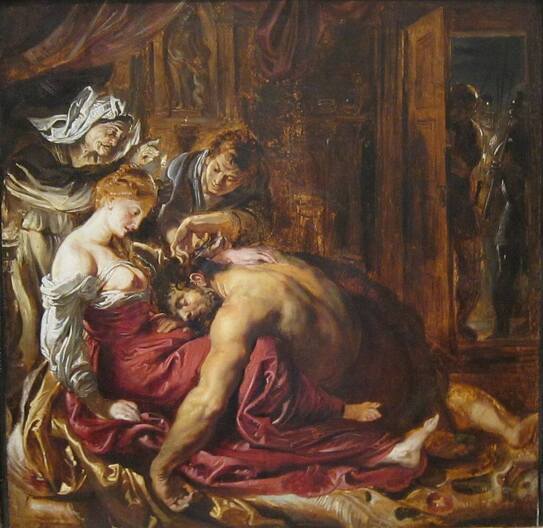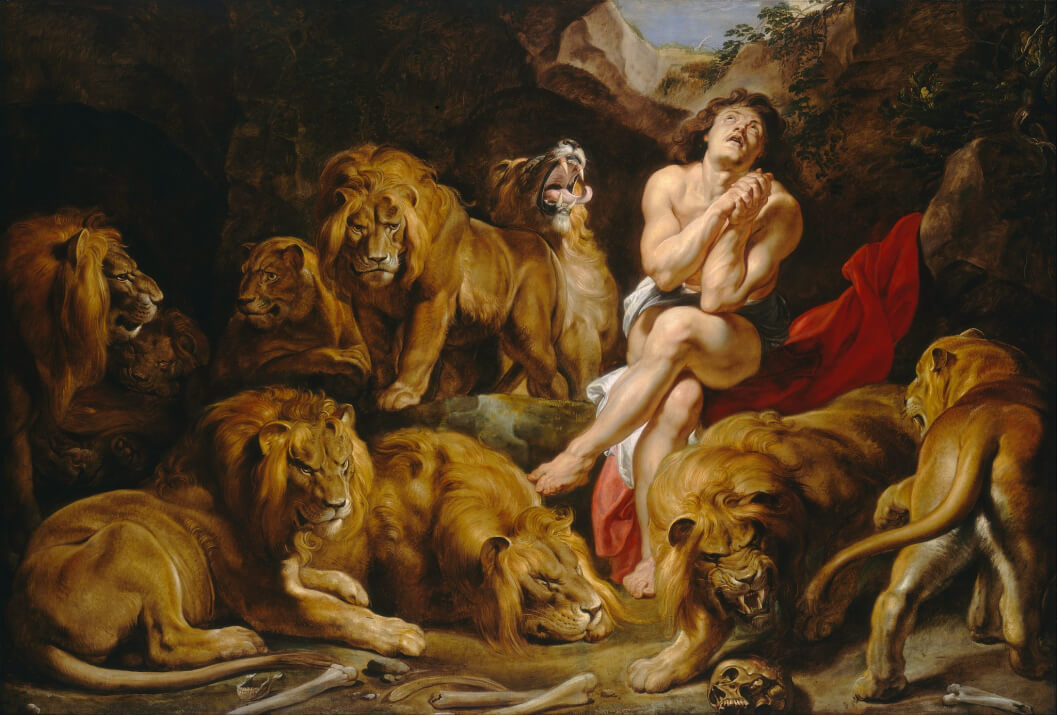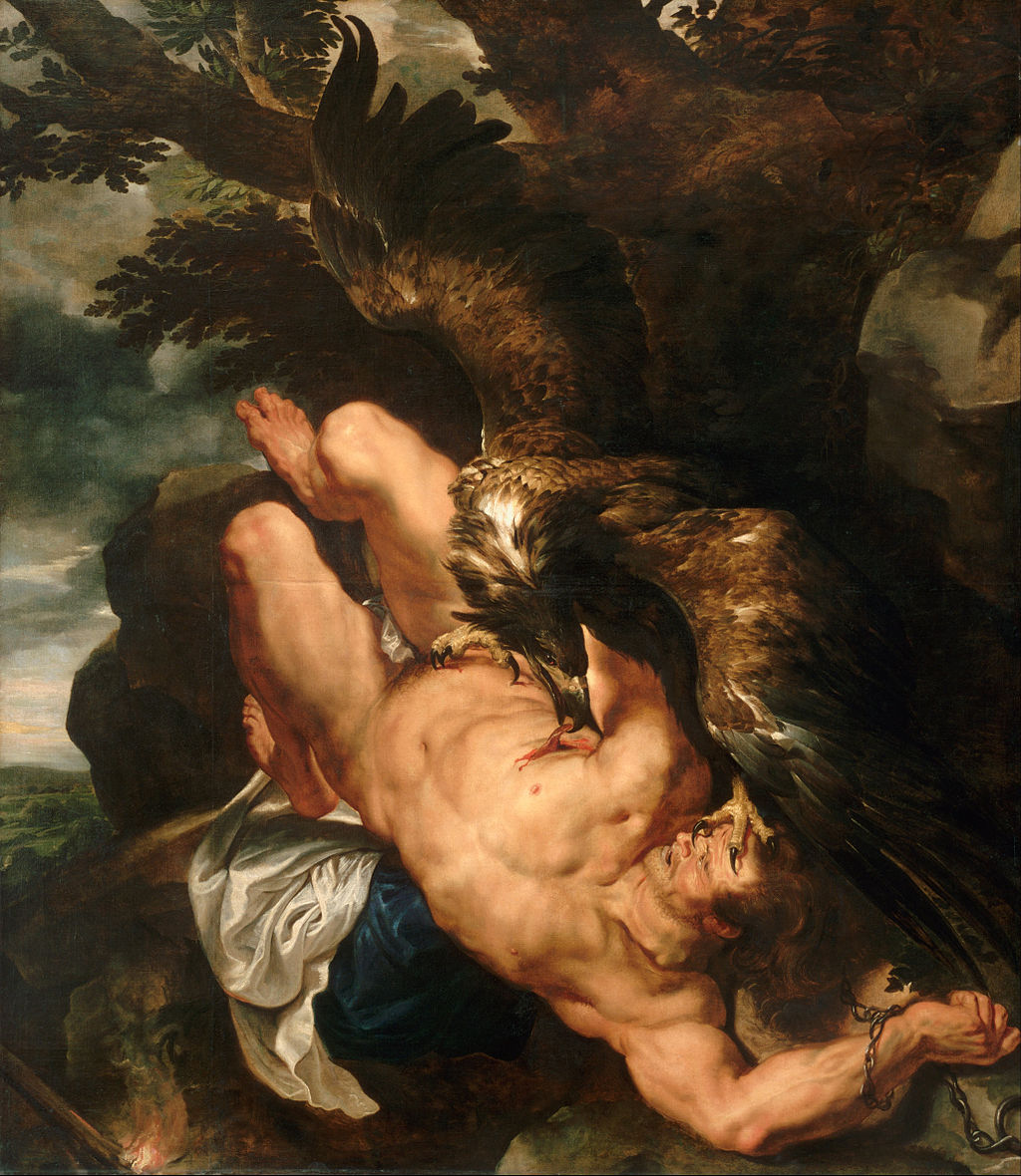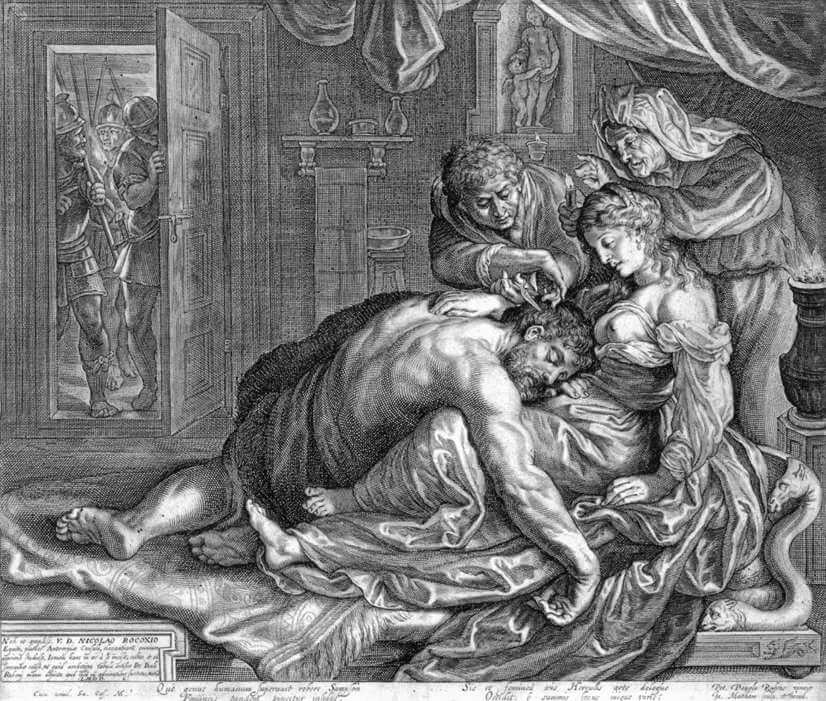|
Where? Room 18 of the National Gallery
When? 1609-1610 Commissioned by? Nicolaas II Rockox, a kind of mayor of Antwerp What do you see? Samson and Delilah are lying in a bed. The very muscular Samson is almost naked and sleeping on the lap of Delilah. He is only wearing an animal skin (possibly of a lion that he killed with his bare hands) around his middle. Delilah is wearing a white dress with a red satin cloak and has her breasts exposed. Her face shows a gentle expression and her left hand is placed on the shoulder of Samson. The man behind Samson cuts his hair which was the source of Samson’s extraordinary strength. On the left side, an old woman is holding up a candle to provide enough light to cut Samson’s hair. On the bottom right, below Samson and Delilah, is an expensive woven carpet. On the top right, the Philistine soldiers are waiting outside the door with their weapons to capture Samson after his hair is cut. In the background of the room are various decorations. Notably, on the top left is a statue of Venus and Cupid. A large purple curtain surrounds the statue. Backstory: This painting was acquired by the National Gallery in 1980 for about $6 million. At that time, it was the second-most expensive painting in the world. This painting hung originally above a very large fireplace in the house of Nicolaas II Rockox. The bottom of the painting was about three foot/meter above the floor. Rubens created the painting such that it is best appreciated when viewed from below, though it is difficult in the current museums to hang a painting that high above the floor. A preliminary study for this painting is in the Cincinnati Museum of Art.
The Biblical story of Samson and Delilah: The story of Samson is described in Judges 13-16. He was a judge of the Israelites and received an immense strength from God to fight his enemies. The only condition to not lose his strength was that he could not cut his hair. He used his strength multiple times against the Philistines, the enemy of the Israelites.
However, as described in Judges 16, one day he falls in love with the Philistine girl Delilah. The Philistines bribe Delilah to help them to capture Samson. Delilah asks Samson multiple times what the secret of his strength is such that the Philistines can get rid of it. After telling a couple of lies first, he finally tells her that the secret is that he cannot cut his hair and that he never did (interestingly, his hair is rather short in this painting). Delilah makes Samson fall asleep in her lap and a servant cuts his hair. When the Philistines come to capture him, God has left Samson and he has lost his strength. He gets captured by the Philistines and is put in prison. After that Samson got his strength back one more time from God and killed himself and more Philistines than he had done his entire life. Symbolism: The moral of this painting is that love can cause problems. Some people even suggest that this painting portrays a brothel and if that is the case, the message of Rubens is that you should not visit those. The crossed hands of the man cutting the hair of Samson symbolize betrayal. The statue of Venus and Cupid in the background shows that the mouth of Cupid is covered by a cloth such that he cannot speak. This is an uncommon way to depict Cupid and symbolizes the belief of Samson that love (represented by Cupid) can lead to bad outcomes. Who is Rubens? Peter Paul Rubens (1577-1640) is one of the most famous Baroque painters. Between 1600 and 1608, he spent a considerable amount of time in Italy and visited, among other cities, Venice, Florence, and Rome. He was able to see a lot of art masterpieces there and was particularly inspired by the works of Caravaggio, Leonardo da Vinci, Michelangelo, and Raphael. In 1608, he moved back to Antwerp where he started his extensive studio. Rubens developed a unique painting style with an emphasis on color, movement, sensuality, and light. He created a large number of paintings, including religious ones such as the current painting and Daniel in the Lions’ Den in the National Gallery of Art, and mythological paintings such as Prometheus Bound in the Philadelphia Museum of Art.
Fun fact: There has been quite some debate over time about whether Rubens actually created this painting. While there is no doubt that Rubens created a painting of Samson and Delilah, the question is whether the version in the National Gallery is the one that Rubens painted or whether the real Rubens has been lost.
An important argument that this may not be a Rubens is related to a copy of the real Rubens painting in 1613 by Jacob Matham. There are several differences between the copperplate engraving of Matham and the painting of Rubens, such as the right foot of Rubens which is not entirely in the painting, the position of the old woman, the statue of Venus and Cupid in the background, and the carpet. The main argument that this painting is not by Rubens is that the copy by Matham is more in line with the other paintings of Rubens than the painting in the National Gallery. However, nowadays most people believe that Rubens did make the painting in the National Gallery.
Written by Eelco Kappe
References:
0 Comments
Leave a Reply. |
Categories
All
|
- Home
- Blog
-
Museums
- Alte Pinakothek
- Art Institute of Chicago
- Baltimore Museum of Art
- Barber Institute of Fine Arts
- Bargello
- Barnes Foundation
- British Museum
- Church of Sant’Anastasia
- Cleveland Museum of Art
- Courtauld Institute of Art
- Detroit Institute of Arts
- Frans Hals Museum
- Galleria Borghese
- Gallerie dell'Accademia
- Getty Museum
- Guggenheim
- Hermitage Museum
- Kunsthistorisches Museum
- Kunstmuseum Basel
- Legion of Honor Museum
- Louvre
- Mauritshuis
- Metropolitan Museum of Art
- Musee d’Orsay
- Museum of Fine Arts in Boston
- Museum of Modern Art
- National Gallery in London
- National Gallery of Art
- National Museum in Poznań
- Norton Simon Museum
- Ny Carlsberg Glyptotek
- Palace of Versailles
- Palazzo Pitti
- Palazzo Vecchio
- Petit Palais
- Philadelphia Museum of Art
- Prado
- Pushkin Museum
- Ravenna Art Museum
- Rijksmuseum
- San Diego Museum of Art
- Santa Maria delle Grazie
- St. Peter's Basilica
- Städel Museum
- Statens Museum for Kunst
- Tate Britain
- Tate Modern
- Timken Museum of Art
- Uffizi
- Vatican Museums
- Wallace Collection
-
Artists
- Altdorfer
- Anguissola
- Berlin Painter
- Bosch
- Botticelli
- Boucher
- Bronzino
- Bruegel the Elder
- Brunelleschi
- Cabanel
- Caillebotte
- Canova
- Caravaggio
- Carpeaux
- Cezanne
- Cimabue
- David
- Degas
- Delacroix
- De Maria
- Donatello
- El Greco
- Fontana
- Fra Angelico
- Fragonard
- Gauguin
- Gentileschi
- Gericault
- Gonzalez-Torres
- Goya
- Hals
- Hogarth
- Hokusai
- Ingres
- Leonardo da Vinci
- Lippi, Filippo
- Longhi, Barbara
- Lorrain
- Makovsky
- Manet
- Massys
- Matisse
- Merian
- Michelangelo
- Mochi
- Modigliani
- Monet
- Panini
- Parmigianino
- Perugino
- Picasso
- Pisanello
- Raphael
- Rembrandt
- Renoir
- Reynolds
- Rivera
- Rodin
- Rubens
- Scultori
- Seurat
- Steen
- Tintoretto
- Titian
- Toulouse-Lautrec
- Turner
- Uccello
- Van der Weyden
- Van Dyck
- Van Eyck
- Van Gogh
- Van Hemessen
- Vasari
- Velazquez
- Vermeer
- Veronese
- Vigée Le Brun
-
Locations
- Books
- About Us

